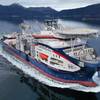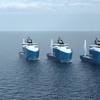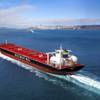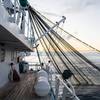EPA’s Vessel General Permit (VGP) & You
Nothing stirs the maritime pot like new regulation, and coming soon to you (in less than a month) is the new iteration of the Vessel General Permit (VGP). The VGP applies to vessels operating in a capacity as a means of transportation, that have discharges incidental to their normal operations into waters subject to this permit, except recreational vessels. Unless otherwise excluded from coverage, the waters subject to this permit means “territorial seas” of the U.S. The Clean Water Act (CWA) does not require NPDES permits for vessels or other floating craft operating as a means of transportation beyond the territorial seas, such as in the contiguous zone or ocean. The Environmental Protection Agency (EPA) is issuing a replacement VGP permit under its authority from the CWA. The new VGP provides effluent limits for 27 specific discharge categories.
The types of vessels covered under the VGP include commercial fishing vessels, cruise ships, ferries, barges, mobile offshore drilling units, oil tankers or petroleum tankers, bulk carriers, cargo ships, container ships, other cargo freighters, refrigerant ships, research vessels, emergency response vessels, including firefighting and police vessels, and any other vessels operating in a capacity as a means of transportation. While all non-recreational vessels, which are not vessels of the armed forces, may seek coverage under this permit. The permit requirements are generally targeted to vessels that are at least 79 feet in length. The EPA estimates that the domestic vessel population subject to the VGP is approximately 60,000 vessels; it estimates approximately 12,400 foreign flagged vessels are subject to the VGP requirements.
Lubricants Companies Invest
As with any new industry rule, those that stand to gain business from new requirements work well in advance to ensure that its product and service line-up is well-positioned to prosper. This has been the case with VGP, particularly with lubricant and fluids manufacturers that for years have been tasked to refine product that are more environmentally benign while maintaining performance standards.
“To ensure ExxonMobil Marine Fuels and Lubricants can help operators to meet the stringent requirements, we have developed a new comprehensive series of synthetic, environmentally acceptable lubricants, the Mobil SHC Aware range,” said Iain White, Global Field Marketing Manager, ExxonMobil Marine Fuels & Lubricants. The new Mobil SHC Aware range has been formulated to not only help engineers comply with the new marine operating practices, but to enhance vessel reliability, minimize maintenance costs and reduce potential environmental impact. The Mobil SHC Aware range includes:
• Mobil SHC Aware H hydraulic
fluids
• Mobil SHC Aware ST stern tube
lubricants
• Mobil SHC Aware Grease
EP 2 multi-purpose grease
• Mobil SHC Aware Gear range
of gear oils
“RSC Bio Solutions has a legacy of developing these kinds of products since 1996, and we have worked with OEMs and other industry stakeholders for quite some time to deliver technically sound, environmentally acceptable products with high performance,” said Mike Guggenheimer, President & CEO, RSC Bio Solutions.
“In light of the recent changes to the VGP regulation, RSC Bio Solutions undertook a significant process to repeat our documentation and testing studies on biodegradation, toxicity, bioaccumulation to ensure we would be able to unequivocally certify our products as compliant. RSC Bio Solutions has also extended our production and distribution network as the market for EALs has grown on a global stage.
Our EnviroLogic EALs (100 Series and 3000 Series) are suitable, proven and approved for a wide range of applications, including controllable pitch propellers, thruster and hydraulic fluids and other oil-to-sea interfaces including lubrication discharges from stern tubes, thruster bearings, stabilizers, rudder bearings, azimuth thrusters, propulsion pod lubrication, wire rope and mechanical equipment subject to immersion. Applications for our SAFECARE cleaners include deck and equipment washing, general purpose cleaning, degreasing, parts cleaning and oil stain removal,” Guggenheimer concluded.
In a discussion on the show floor in New Orleans last month, Panolin maintains that it was already well-ahead of the VGP game as it has nearly 30 years experience producing environmentally-considerate lubricants. Panolin offers its VGP-compliant Greenmarine products to help owners and operators meet the imminent EPA requirements. Panolin Greenmarine lubricants use fully saturated synthetic esters and specially developed additives to achieve 100% VGP and sVGP compliance without sacrificing performance. The range includes hydraulic fluids, gear oil and production line control fluids, as well as lubricants for stern tubes, gear boxes, cables and sliding parts. These products have proven themselves through harsh continued use in dredging, offshore, subsea, marine and hydropower applications with customers around the world. These synthetic lubricants are designed to separate from water easily and quickly due to their fully saturated ester compound, and possess self-drying characteristics when heated. Their higher affinity to water and moisture content allows for water separation and removal, providing long-term product stability and durability. By also decreasing the frequency of oil changes and enhancing operating efficiency, these products effectively reduce CO2 emissions.
Castrol Marine believes in developing an entire range of marine grade lubricants based on an unfolding legislative program, and at the same time securing OEM approvals ahead of time. But it also believes its coordinated efforts to share regulatory knowledge with customers will not be sufficient; only by working with customers to forecast the size and location centers of demand for its EAL compliant range can it claim to offer a truly market responsive approach.
Castrol BioStat and BioBar ranges are registered under OSPAR (Convention for the Protection of the Marine Environment of the North-East Atlantic) and therefore meet the criteria for being EALs under the VGP. Owners will also need to be assured that the products they select meet acceptable standards in terms of performance. Here, Susannah Linington, Castrol Marine Environmental Specialist, explains that Castrol Marine has spent the four years since the revised VGP was first raised securing OEM approvals for BioRange products in the marine context.
As important as performance is that the product is documented to meet the new requirements, ultimately the vessel owner is responsible. “Claims for ‘environmentally responsible’ products are made widely but can sometimes be misleading,” said Linington. “It is a great step forward having defined criteria for determining the environmental performance of marine lubricants. This means that environmental claims can be backed up by relevant scientific testing.”
According to Linington, Castrol’s first principle for BioRange was to offer drop-in replacements for lubricants based on conventional mineral oils.
Finally, Vickers said its HYDROX BIO, ECOSURE HSE and BIOGREASE EP2 ranges of Environmentally Acceptable Lubricants (EALs) meet the detailed ecological definitions and requirements laid down in the 2013 Vessel General Permit (VGP). Vickers Oils has approvals for its EALs from many of the relevant equipment manufacturers. Stocks are carried in ports around the world.
What’s it Going to Cost?
It wouldn’t be a new rule if it didn’t hit your bottom line. The table below provides the EPA’s projected low end and high end estimates concerning the General Inspection and Paperwork costs associated with compliance across the board for the VGP.
Vessel Class Low End Estimate High End Estimate
Commercial Fishing $34,496 $254,545
Freight Barges $193,893 $193,893
Freight Ships $20,593 $20,593
Passenger Vessels $15,322 $15,322
Tank Barges $34,839 $34,839
Tank Ships $8,661 $8,661
Utility Vessels $102,182 $102,182
Total $409,986 $630,036
(As published in the November 2013 edition of Maritime Reporter & Engineering News - www.marinelink.com)











